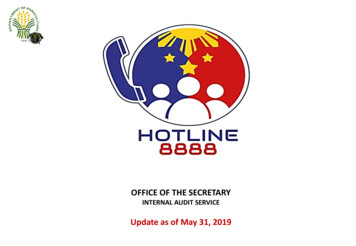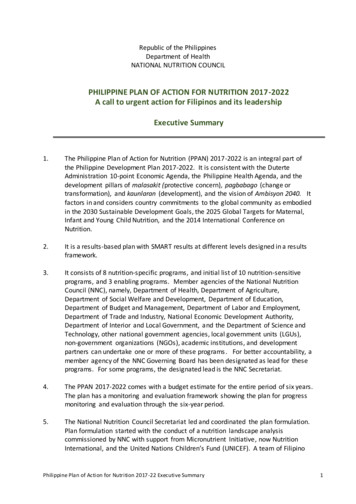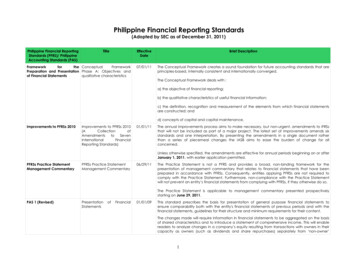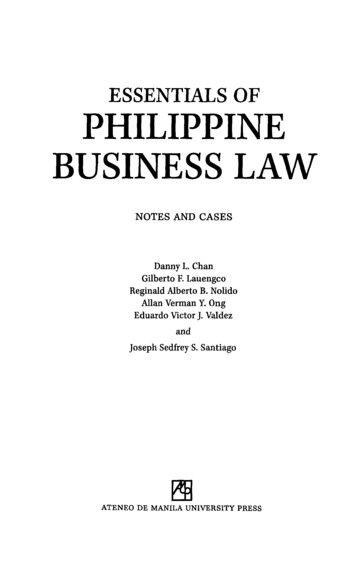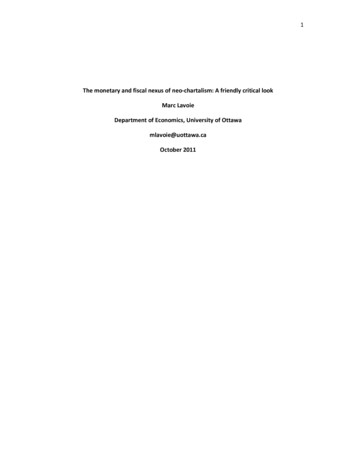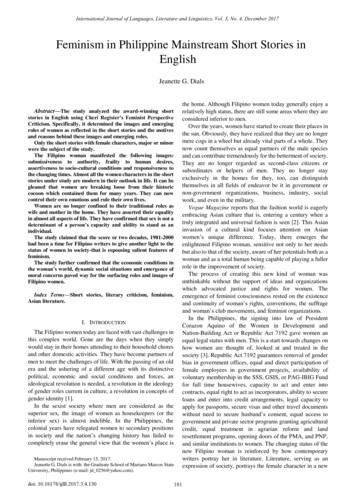
Transcription
International Journal of Languages, Literature and Linguistics, Vol. 3, No. 4, December 2017Feminism in Philippine Mainstream Short Stories inEnglishJeanette G. Dials Abstract—The study analyzed the award-winning shortstories in English using Cheri Register’s Feminist PerspectiveCriticism. Specifically, it determined the images and emergingroles of women as reflected in the short stories and the motivesand reasons behind these images and emerging roles.Only the short stories with female characters, major or minorwere the subject of the study.The Filipino woman manifested the following images:submissiveness to authority, frailty to human desires,assertiveness to socio-cultural conditions and responsiveness tothe changing times. Almost all the women characters in the shortstories under study are modern in their outlook in life. It can begleaned that women are breaking loose from their historiccocoon which contained them for many years. They can nowcontrol their own emotions and rule their own lives.Women are no longer confined to their traditional roles aswife and mother in the home. They have asserted their equalityin almost all aspects of life. They have confirmed that sex is not adeterminant of a person’s capacity and ability to stand as anindividual.The study claimed that the score or two decades, 1981-2000had been a time for Filipino writers to give another light to thestatus of women in society-that is espousing salient features offeminism.The study further confirmed that the economic conditions inthe woman’s world, dynamic social situations and emergence ofmoral concerns paved way for the surfacing roles and images ofFilipino women.Index Terms—Short stories, literary criticism, feminism,Asian literature.I. INTRODUCTIONThe Filipino women today are faced with vast challenges inthis complex world. Gone are the days when they simplywould stay in their homes attending to their household choresand other domestic activities. They have become partners ofmen to meet the challenges of life. With the passing of an oldera and the ushering of a different age with its distinctivepolitical, economic and social conditions and forces, anideological revolution is needed, a revolution in the ideologyof gender roles current in culture, a revolution in concepts ofgender identity [1].In the sexist society where men are considered as thesuperior sex, the image of women as housekeepers (or theinferior sex) is almost indelible. In the Philippines, thecolonial years have relegated women to secondary positionsin society and the nation’s changing history has failed tocompletely erase the general view that the women’s place isManuscript received February 15, 2017.Jeanette G. Dials is with the Graduate School of Mariano Marcos StateUniversity, Philippines (e-mail: jd 0256@yahoo.com).doi: 10.18178/ijlll.2017.3.4.130181the home. Although Filipino women today generally enjoy arelatively high status, there are still some areas where they areconsidered inferior to men.Over the years, women have started to create their places inthe sun. Obviously, they have realized that they are no longermere cogs in a wheel but already vital parts of a whole. Theynow count themselves as equal partners of the male speciesand can contribute tremendously for the betterment of society.They are no longer regarded as second-class citizens orsubordinates or helpers of men. They no longer stayexclusively in the homes for they, too, can distinguishthemselves in all fields of endeavor be it in government ornon-government organizations, business, industry, socialwork, and even in the military.Vogue Magazine reports that the fashion world is eagerlyembracing Asian culture that is, entering a century when atruly integrated and universal fashion is seen [2]. This Asianinvasion of a cultural kind focuses attention on Asianwomen’s unique difference. Today, there emerges theenlightened Filipino woman, sensitive not only to her needsbut also to that of the society, aware of her potentials both as awoman and as a total human being capable of playing a fullerrole in the improvement of society.The process of creating this new kind of woman wasunthinkable without the support of ideas and organizationswhich advocated justice and rights for women. Theemergence of feminist consciousness rested on the existenceand continuity of woman’s rights, conventions, the suffrageand woman’s club movements, and feminist organizations.In the Philippines, the signing into law of PresidentCorazon Aquino of the Women in Development andNation-Building Act or Republic Act 7192 gave women anequal legal status with men. This is a start towards changes onhow women are thought of, looked at and treated in thesociety [3]. Republic Act 7192 guarantees removal of genderbias in government offices, equal and direct participation offemale employees in government projects, availability ofvoluntary membership in the SSS, GSIS, or PAG-IBIG Fundfor full time housewives, capacity to act and enter intocontracts, equal right to act as incorporators, ability to secureloans and enter into credit arrangements, legal capacity toapply for passports, secure visas and other travel documentswithout need to secure husband’s consent, equal access togovernment and private sector programs granting agriculturalcredit, equal treatment in agrarian reform and landresettlement programs, opening doors of the PMA, and PNP,and similar institutions to women. The changing status of thenew Filipino woman is reinforced by how contemporarywriters portray her in literature. Literature, serving as anexpression of society, portrays the female character in a new
International Journal of Languages, Literature and Linguistics, Vol. 3, No. 4, December 2017perspective: autonomous, decisive, capable and professional.Seeing the Filipino woman in that light is made possible bythe emergence of a new approach in literary criticism – thefeminist criticism [4].The female literary tradition comes from the still evolvingrelationship between women writers and their society.Moreover, literary historians cannot treat the femaleimagination as a romantic or Freudian abstraction. It is theproduct of a delicate network of influences operating in time,and it must be analyzed as it expresses itself, in language andin fixed arrangement of words on a page, a form that itself issubject to a network of influences and conventions; includingthe operations of the marketplace. Engraved in the tablets ofPhilippine history are the 80s, 90s and early 20th century. Thisis the generation that made people see the arduous journeyfrom dictatorship to the long-sought and cherished return todemocracy. It is while on this journey that artists rose to shapeand mold anew the nation’s awareness of stirring socialchanges. This was the score of hopes and dreams yet bore itsshare of pain and tribulation as well. Significant humanexperiences and events from this era are the threads theFilipino writers began to weave into a tapestry that displays anation’s courage and victory, the nobility of the human spiritand resilience of the artist’s creativity. The weave is avaluable document of history.It is in this light that the award-winning stories are taken assubject in this study.unmistakably Filipino are best illumined since such traits havebeen faithfully delineated by each of the heroines on the fournovels. Moreover, said study greatly dealt with the manyinstances the heroines were able to redeem themselves.The present study is similar to Apostols’s [5]. since bothfocused on the new image being assumed by thecontemporary Filipino woman as depicted by the womencharacters in the text. However, the latter also considered notonly the protagonists but also the antagonists. Prize-winningshort stories that were considered for analysis were not onlywritten by female writers but also of male writers. Throughthis, the researcher believed that she would more likelypresent an unbiased as well as balanced view on the Filipinowoman.De Guzman [6] identified the types of women as seenthrough the female characters of F. Sionil Jose’s twelvestories. This study dealt with the five types of women asdepicted in Jose’s fictive writing: martyr, victim, bitter orangry woman, woman in transition and the healer. Since thewomen portrayed different roles in Philippine society, DeGuzman stated that they could be any of these: domesticated,kept woman, pleasure seeking or revolutionary.Slightly similar to the researcher’s study is De Guzman’schoice of a male writer in F. S. Jose. The present researcherhowever, looked into the short stories written by both maleand female writers who have a more in-depth study on theextent of feminism in contemporary times.De Guzman pointed out that F.S. Jose maintained a balancein the projection of his female characters to depict hispro-feminist stand and his being a male writer; that ofshowing the holistic view of the person through her strengthsand weaknesses.Arellano’s [7] “Contemporary Images of Filipino Men andWomen” as depicted in the Liwayway Magazine stressed onepoint. She claimed that the short stories represent the complexinterrelations of political and social forces in a society. Sheemphasized that the stories foreground the discourse that eventhe individualistic, educated, modern career woman acceptsthat it is her natural fate to perform the “triple burden” ofmother, care-giver and breadwinner but can also willinglydefy convention if only to assert her mother roles.Likewise, she mentioned that the male professionalcharacters depicted in the short stories are represented to bedecisive, intelligent, successful in their careers, faithful,responsible, industrious and chivalrous thus, affirming thestereotype idea of patriarchy that men are given to intelligence,rule, warfare, and other altruistic projects expected to servemankind and promote civilization.Arellano further noted that feminist authorship inLiwayway although still a minority, breaks the literary silenceof women by taking the discourse of “otherness” of narrative,point of view, characterization, tone, and focus in the tellingof a story. She further affirmed that radical feminist textspromise to evolve from the printed work of short fiction inLiwaywaySerrano [8] claimed that the Filipino woman as depicted inthe contemporary novels has varied images under which shecould be categorized; the ever-sacrificing wife, the femmefatale, the nymphet, the over ambitious shrewd politician andthe committed street parliamentarian. She pinpointed the factII. OBJECTIVES OF THE STUDYThis study analyzed award-winning contemporaryPhilippine short stories in English written by both male andfemale writers using Cheri Register’s Feminist PrescriptiveCriticism.Through an in-depth study and analysis, it sought to:1) find out and discuss the images of Filipino women asdepicted in the mainstream Philippine short stories inEnglish;2) discuss the emerging roles of Filipino women reflectedin the short stories;3) identify the motives and reasons behind the images andemerging roles of Filipino women.III. REVIEW OF LITERATUREA. Images and Roles of WomenThe image of the Filipino women for the past two decadeswas influenced by the changes in the Filipino women’s livesfinding expression in the already highly developed short storyin English. The images of strong women are reflected in theshort stories, an indication of the growing consciousness ofwomen that they have found among themselves. Thecontemporary Filipino short stories in English reflectwomen’s role in social development and cultural growth [4].Garcia [5] studied the leading Filipino woman characters inthe four novels of Liwayway A. Arceo. She unfolded a newimage of a Filipino woman – assuming, as depicted in theheroines of Arceo’s novels. Character traits that are182
International Journal of Languages, Literature and Linguistics, Vol. 3, No. 4, December 2017that the Filipino woman has changed greatly her image fromthe traditional coy Maria Clara to the modern Filipina, daringand committed due to the varied factors that greatlyinfluenced the change of image such as socio-economic andpolitical conditions, as well as personal ambitions.The researcher’s study is similar in this light: that oflooking into the possibilities of change in the woman asportrayed by mainstream writers of contemporary times.respect, caring, reciprocity, self-determination, andinterconnection. Some feminists extend these values to allcreatures on the planet as well as the planet itself. In otherwords, they see all living beings as entitled to live life fullyand to be affirmed and valued as unique and significantcontributors to the universe.Hooks [10] defines feminism as the struggle to end sexistoppression. She explains that to be feminist in any authenticsense of the term is to want for all people, female and male,liberation from sexist role patterns, domination andoppression. It is a struggle therefore to end domination.These myriad definitions of and perspectives on feminismsuggest that there are a variety of kinds of feminisms andfeminists. This variety opens up choices and possibilities andspeaks to the very nature of feminism. It is rooted in choiceand self-determination and does not prescribe one officialposition that feminists must hold. Feminism is also anevolving process that necessarily changes as conditions in theworld change and as feminists develop new understandings.Feminism is a commitment to a set of principles or values.The feminist therefore is committed to enacting in the worldthe values of self-determination, immanent value, affirmation,mutuality, and care. She is committed to eliminate oppression,domination and hierarchy in all of their manifestations. It is away of living one’s lives and acting in ways that allow othersto make choices that affirm them and their perspectives, andthat do not oppress and exploit [11].B. Feminism DiscussedFeminism is a vital engaging, and exciting perspective fromwhich to view virtually every facet of life. Feminism is sointegral to life that one cannot imagine not being a feminist.This perspective may seem surprising given that feminism hassuch negative connotations in popular culture. When manypeople think of feminism and feminists, they envision angrywomen- perhaps in combat boots, flannel shirts, and nomakeup- who spout harsh, anti-male slogans or otherwiseassert power over men. Although some feminists may engagein some of these activities, not all feminists do. What isimportant to note is that there are many kinds of feminismsand feminists, and feminism is a much more complex mode ofbeing in the world than any of these images suggest.Most definitions of feminism are ones that are believed bymany individuals who would support if they understoodfeminism apart from its stereotypically negative associations.West [9] suggests that self-definition is central to herunderstanding of the term: “I myself have never been able tofind out precisely what feminism is: I only know that peoplecall me a feminist whenever I express sentiments thatdifferentiate me from doormat.” Women’s articulations oftheir own experiences and ideas and their claims to the right todetermine how their lives will proceed, then, are key aspectsto feminism.Other definitions of feminism focus on the concept ofequity, with a goal of reorganizing society on the basis ofequality for the sexes in all areas of social relations.Definitions rooted in equity focus on the achievement ofequality for women with men and the development ofopportunities for women’s expression and self–fulfillment inall realms of life, without the constraints of genderexpectations. Feminists who embrace this definition offeminism seek an equal share of the opportunities to whichmen have access.Other feminists are concerned with the development ofalternative social systems and ways of being in theworld–ways that are grounded in woman-centered principlesand values. Some of these feminists separate from men inorder to discover the kinds of lives that are possible forwomen outside of patriarchy. Still others believe thatseparation from men is infeasible or unrealistic and that awoman-centered perspective can be enacted in the currentworld despite the on-going persistence of patriarchy.Many feminists now expand the use of the term feminism toinclude eliminating the oppression of all people who aremarginalized by the dominant culture, including but notlimited to people of color, people with disabilities, people ofdifferent ages and socioeconomic classes, and lesbians andgay men. Such definitions of feminism suggest the treatmentof all humans in accordance with such feminist values asC. Importance of FeminismK. Floss and C. Griffin in their book Feminist RhetoricalTheories point that feminism is an important perspective for atleast it validates values and experiences often associated withwomen. Some of our most meaningful experiences haveinvolved women, and feminism celebrates and honors suchexperiences [11].Feminism is also important because it gives voice toindividuals marginalized and devalued by the dominantculture and thus provides a more holistic understanding of theworld. Feminism takes seriously not only the experiencesassociated with women but also those of all marginalizedgroups, whether people of color, people with disabilities,lesbians and gay men, or any other group that is not featuredin the dominant culture. Feminism takes seriously theirperspectives and suggests that these perspectives are asvaluable as those that characterize the dominant culture. Theresult is a greater repertoire of options for living andcommunicating to all individuals.Furthermore, feminism is important because it is believedto establish and legitimize a value system that privilegesmutuality, respect, caring, power-with, interconnection, andimmanent value. These values stand in direct contrast to thosethat characterize the dominant culture- hierarchy, competition,domination, alienation, and power-over, for example.Feminism therefore, offers a model for different ways ofliving in the world.To Hooks in the Feminist Rhetorical Theories [10],feminism does not only aim at eradicating the ideology ofdomination but also functions as a constructive, proactiveforce. It seeks to transform relationships and the culture sothat alienation, competition, and dehumanization that183
International Journal of Languages, Literature and Linguistics, Vol. 3, No. 4, December 2017characterize human interaction can be replaced with feelingsof mutuality, intimacy, and camaraderie.Feminism offers women not liberation but the right to act assurrogate men.V. FINDINGSValues, issues, morals, laws, traditions and developmentsof the society may be clearly gleaned from literature as itcaptures the different human experiences of people. Likewise,the people’s sentiments, ideas, feelings, and opinions arereflected. It is safe to claim therefore that it is throughliterature where these are preserved from one generation tothe other. And one way of transmitting such is characterstereotyping. In novels, short stories and plays, the female hasbeen made to act out roles that society has traditionallyreserved for women – the obedient wife, the loving mother,the patient teacher, the responsible elder sister, all of whomare ordained by God and society to render service where andwhen needed [12].Likewise, she is pictured and described as subservient,emotional, sentimental, irrational and docile. In the shortstories under study, the kinds of roles and images they portrayvary. They range from the subservient to the assertive,conventional to modern, prostitute to decent, pessimistic tooptimistic, inferior to superior (as to men). The images theyproject and roles they play in these stories have underlyingreasons. Each has a story to tell.In the study, the following images of women can be gleaned:submissive, frail, assertive and modern.Submissiveness. In Hog Heaven, Jessie B. Garcia presentsMelissa, the female major character, as the daughter of adrunkard who lives at the topmost floor of an old abandonedfour-storey building in Quiapo that overlooks Quezon bridgefrom one angle and the murky Pasig River from another. Thebuilding is just awaiting the wrecker’s ball. She never saysany word to his father despite the very poor condition they arein. She just allows circumstances to operate in her life. Shejust continues to serve him every time he is drunk.Melissa is alone and longing to be loved. She may notaccept it but her actions would speak for it. Instead of lettingher father know that a man is pestering her, she decides not totell him simply because she felt it was a nice feeling and thatshe has never experienced being caressed.At one point, the narrator can not control his feelings forher, of course mixed with sympathy and apathy for her as shesees her sobbing so he wanted to shield her from impendingmiseries. He passionately kisses her face drenched with tears.Her innocence makes her simply succumb to the situation.She can not refuse the narrator in his sexual advancements.Her submissiveness affects her as a person. She could notresent the wills of the narrator. She becomes blind to thereality that he could not be with her forever, that he has otherpriorities in life. She is so passive. She is too weak to make astand and show resentment.Another degree of submissiveness is evident in the case ofMrs. Quinton in the Oldtimer written by Jose Y. Dalisay. Sheaccepts her fate as the partner of her husband in life. Shesubmits to the role of a wife, his inspiration. In a way, Edna ofReprieve also displays this image. Her silence every time hersick husband nags him speaks that she still respects andconsiders the status of a man in her home. Likewise, shedisplays tremendous compliance to her husband’s wisheswhen he asks her to do some tasks for him.IV. METHODOLOGYThis study made use of the descriptive and analyticmethods of research. The descriptive method has for itspurpose to describe phenomena, in contrast to ascertainingwhat caused them or what their value and significance are. Itrequires the gathering of facts for description. In analyzing theshort stories, something is described in terms of componentparts whereby the roles, emerging roles and motives ofcharacters are analyzed based on their lines, situations andother elements in the stories.The following steps were observed in the course of thestudy.1. Reading of related literature and studies. Theresearcher went through extensive reading of references in thedifferent libraries of universities and colleges in Region I,Cordillera Autonomous Region and Metro Manila includingthe CCP library, National Library and UP Center for WomenStudies. She also referred to some magazines, newspapers,books, reviews, articles in the Internet, periodicals,government documents, thesis and dissertations. Throughthese, she was able to get a wider knowledge of the topicunder study.2. Determining the short stories for analysis. Theresearcher looked for the list of Philippine short stories inEnglish written from 1985 to 2005 from available books thatare written by mainstream writers, both female and male. Shechose the first prize-winning short stories in English writtenfrom this period because of their literary merits. She read thestories to ensure that they project female consciousness, aswell as, reveal perceptions of the Filipina as to hertemperament, image and status in Philippine society from theperspective of both the male and female writers. She noteddown the title of the story, title of the book, author and thedate of publication of the book. The details of which wereneeded in the course of the study.3. Reading of the short stories. The researcher read thestories for the second time, this time for understanding. Athorough investigation of the story was conducted in her thirdreading specifically looking into the feminist touches of thestories. The stories that were found out to have no femalecharacters were not anymore considered in this phase.4. Analysis of the short stories. The researcher at thisstage analyzed the short stories one at a time using theprescriptive criticism approach. The analyses ranged fromciting lines/paragraphs to critical analysis of thesituations/incidents in the stories.5. Holistic evaluation of the short stories. The researcherat this point wrote an over-all evaluation of the storiescentering on the images of women and the contemporary rolesof women that could be in the short stories under study. Aftereliciting the images and emerging roles of women, theresearcher looks and finds out the motives behind such imagesand roles.184
International Journal of Languages, Literature and Linguistics, Vol. 3, No. 4, December 2017Letters presents scenes in the life of a woman who lives in anera when prevailing ideas about women may seemunacceptable even in the present time. Leticia is arepresentation of a Filipino woman breaking free from thesocial conventions that bind her. She is unlike Melisa of InHog Heaven who easily succumbs to authority and who givesin to human frailty.As a teacher Leticia employs modern techniques inteaching. Actually, Alan learns a copious source ofinformation about Leticia from her students.The Emerging Roles of Women. Women are identifiedaccording to the roles they play in society although in reality,there is no common accord regarding their role. There aresome who think that their place is still the home with thetraditional things related to it, even if they have to admit thatthey can opt for work, in order to help shoulder the manyexpenses of the family. Others think that the woman shouldassert her rights vis-à-vis man.The women in the short stories under study disclosed theseroles: traditional/domesticated wife or mother, utionary/activist. These female roles confirm the rolesmanifested by women in the study of Arellano [7] and DeGuzman [6]. It should be noted that some of the womencharacters in the short stories under study have more than onerole.Wife/mother. Foremost of these wives in the story is Edna,a devoted wife and a caring mother. She is a middle classworking wife who balances her responsibilities in the homeand in her new work. Despite the emotional and psychologicalpressures brought about by her husband’s temporaryincapability as provider, she remains very calm and tolerant ofher husband’s misdemeanor. Another picture of a wife is Mrs.Quinton in Reprieve. She is painted as the beautiful wife whoinspires her man. Other than the descriptions given by thenarrator with the pictures he receives from Charlie, only a fewcould be said about her.A different concept of a wife is depicted in Our Lady ofArts and Letters. Leticia never cares for her husband. Sherather exchanges him with anybody who fits her fancy. To her,the role of a wife ends when she is no longer contented withher mate.Women without Men (Independent). Leticia defies theconventions of a wife. She chooses to live separately from herhusband because she realizes that he is no longer the personwho could satisfy her needs. She thinks that she is alreadymature enough thus, her preferences have changedtremendously. Instead, she concentrates on her work thoughshe seeks the company of a younger man every time shecraves for the flesh.At the start of the story In Hog Heaven, Melissa feelshelpless and submissive to her father and the narrator.However, when she sees that an illicit relationship is going onbetween Toti and the narrator, she decides to confine herselfin her room, a manifestation of her decision to stay away fromhim, and to start anew without him. Merlie is also anothercharacter who despite her being a prostitute remains directedin her path- that is to go to Japan and become an internationalstar.Frailty. Merlie gives a glimpse of the world of prostitutes.It is human frailty and the need to survive that pushes her toprostitution. The story is a series of impressions and vignettesabout various prostitutes and about the squalid life of the city.The story gives a panorama of the world of prostitutes, theirconditions, their hopes and their dreams, their needs, theirpreferences. They are women who ply the night to trade fleshfor their survival. These impressions and vignettes surroundMerlie, and her attempt to go to Japan. She typifies andconcretizes the grim realities of the city life of the underprivileged, particularly the prostitutes.The story also shows the commodification and confinementof woman in the persona of a prostitute. This therefore is amanifestation that she is a commodity. She is “sold”. Thus,she is subordinate to the man who buys her.Merlie is confined not only to the brothel but to littlecubicles as well. She may have a private space but she has nosense of self-ownership because she is open to all men.Therefore, she can not move on her own, that is, she onlymoves upon the dictates of men.Luisa in The Flight is so innocent yet ever curious whobecame very homophobic in learning about the death of hisuncle. He has lived in pure confusion.In another light, Melissa is a character who displays a weakdisposition. She is a pitiful creature who has no control overher destiny. Unlike Merlie who is exposed to the starkchallenges and bare realities of life due to the nature of herwork (prostitute), Melissa is not exposed due to her physicalimpairment as mentioned earlier. Despite this weakness, sheemerges a fighter. When she senses that something immoral ishappening between the narrator and Toti, she decides to keepher distance from him.Assertiveness. Susan Lara presents her lone femalecharacter vis-à-vis two male characters who regard her as‘built to last’. Edna, a doctor is a caring wife to Leo and aconcerned mother to Sandy. While her husband isrecuperating from his injury, she takes her husband’s scheduleof tending to patients with emergency cases.She is regarded as a man’s equal. Though Sandyvehemently pro
short stories, an indication of the growing consciousness of women that they have found among themselves. The contemporary Filipino short stories in English reflect women’s role in social development and cultural growth [4]. Garcia [5] studied the leading Filipino woman characters

